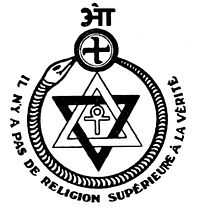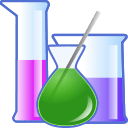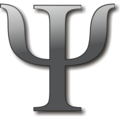
French theosophy logo digitalized
: The Star of David, Ouroboros, positive swastika, ankh and aum. It reads
: "There is no religion higher than truth". Credit:
Mspecht.
Theology is "the rational and systematic study of religion and its influences and of the nature of religious truth [, or] the learned profession acquired by specialized courses in religion (usually at a college or seminary".[1]
Theoretical theology
Def. "reasoning or discussion concerning the Deity"[2], is called theologia.[1]
Def. "the science of things divine"[3], is called theology.[1]
Def. "a deity, a god, God"[4] is called a theos.
Def.
- "[t]he single deity of various monotheistic religions",
- "[t]he single male deity of various duotheistic religions",
- "[a]n impersonal and universal spiritual presence or force",
- "[a]n omnipotent being, creator of the universe (as in deism)",
- "[t]he (personification of the) laws of nature", and
- "[t]he Horned God",[5] is called God.
Usage notes
"God is often referred to by masculine pronouns, not necessarily implying that the speaker believes that God is male. He is also referred to by pronouns that begin with a capital letter, as a sign of respect, in many languages written in Latin script. In English, these would include He, Him, His and Himself. Many Jews follow a prohibition in their tradition against using it and other equivalents in writing (see G-d)."[5]
Locations on Earth

The Holy Land or Palestine shows not only the Old Kingdoms of Judea and Israel but also the 12 Tribes Distinctly. Credit:
Tobias Lotter.
Def. that "part of Asia, consisting mostly of Israel and Palestine, in which most Biblical events are set"[6] is called a Holy Land.
The Holy Land is approximately 31°N latitude.
"The best and still unsurpassed study of a traditional Dayak religion in Kalimantan is that of Hans Scharer, Ngaju Religion: The Conception of God among a South Borneo People; translated by Rodney Needham (The Hague: Martinus Nijhoff, 1963). The practice of Kaharingan differs from group to group, but shamans, specialists in ecstatic flight to other spheres, are central to Dayak religion, and serve to bring together the various realms of Heaven (Upper-world) and earth, and even Under-world, for example healing the sick by retrieving their souls which are journeying on their way to the Upper-world land of the dead, accompanying and protecting the soul of a dead person on the way to their proper place in the Upper-world, presiding over annual renewal and agricultural regeneration festivals, etc.[32]"[7]
Borneo is approximately 1°N latitude. The equator passes through Borneo.
Recent history
The recent history period dates from around 1,000 b2k to present.
"During the High Middle Ages, theology was therefore the ultimate subject at universities, being named "The Queen of the Sciences" and serving as the capstone to the Trivium and Quadrivium that young men were expected to study. This meant that the other subjects (including Philosophy) existed primarily to help with theological thought.[8]"[1]
Hypothesis:
- Religion in the northern hemisphere of Earth has its origins in celestial events that killed hominins.
- There were no deities in the southern hemisphere except in those cultures that also crossed the equator into the northern hemisphere.

This is an image of a Lewis rat. Credit: Charles River Laboratories.
The findings demonstrate a statistically systematic change from the status quo or the control group.
“In the design of experiments, treatments [or special properties or characteristics] are applied to [or observed in] experimental units in the treatment group(s).[9] In comparative experiments, members of the complementary group, the control group, receive either no treatment or a standard treatment.[10]"[11]
Def. a “short and/or incomplete realization of a certain method or idea to demonstrate its feasibility"[12] is called a proof of concept.
Def. evidence that demonstrates that a concept is possible is called proof of concept.
The proof-of-concept structure consists of
- background,
- procedures,
- findings, and
- interpretation.[13]
See also
References
- 1 2 3 4 {{ cite web
|title=WordNet Search - 3.1 for theology
url==http://wordnetweb.princeton.edu/perl/webwn?o2=&o0=1&o7=&o5=&o1=1&o6=&o4=&o3=&s=theology&h=000&j=0#c theology |publisher=Princeton University
|location=Princeton, New Jersey USA
|month=November 23,
|year=2013
|accessdate=2013-11-23
- ↑ City of God Book VIII. i. "de divinitate rationem sive sermonem"
- ↑ Of the Laws of Ecclesiastical Polity, 3.8.11
- ↑ "θεός, In: Wiktionary". San Francisco, California: Wikimedia Foundation, Inc. September 8, 2012. Retrieved 2012-09-17.
- 1 2 "God, In: Wiktionary". San Francisco, California: Wikimedia Foundation, Inc. August 29, 2012. Retrieved 2012-09-17.
- ↑ "Holy Land, In: Wiktionary". San Francisco, California: Wikimedia Foundation, Inc. 12 April 2015. Retrieved 2015-07-02.
- ↑ "Dayak people, In: Wikipedia". San Francisco, California: Wikimedia Foundation, Inc. 2 July 2015. Retrieved 2015-07-02.
- ↑ Thomas Albert Howard, Protestant Theology and the Making of the Modern German University (Oxford: Oxford University Press, 2006), p.56: '[P]hilosophy, the scientia scientarum in one sense, was, in another, portrayed as the humble "handmaid of theology".'
- ↑ Klaus Hinkelmann, Oscar Kempthorne (2008). Design and Analysis of Experiments, Volume I: Introduction to Experimental Design (2nd ed.). Wiley. ISBN 978-0-471-72756-9. http://books.google.com/?id=T3wWj2kVYZgC&printsec=frontcover.
- ↑ R. A. Bailey (2008). Design of comparative experiments. Cambridge University Press. ISBN 978-0-521-68357-9. http://www.cambridge.org/uk/catalogue/catalogue.asp?isbn=9780521683579.
- ↑ "Treatment and control groups, In: Wikipedia". San Francisco, California: Wikimedia Foundation, Inc. May 18, 2012. Retrieved 2012-05-31.
- ↑ "proof of concept, In: Wiktionary". San Francisco, California: Wikimedia Foundation, Inc. November 10, 2012. Retrieved 2013-01-13.
- ↑ Ginger Lehrman and Ian B Hogue, Sarah Palmer, Cheryl Jennings, Celsa A Spina, Ann Wiegand, Alan L Landay, Robert W Coombs, Douglas D Richman, John W Mellors, John M Coffin, Ronald J Bosch, David M Margolis (August 13, 2005). "Depletion of latent HIV-1 infection in vivo: a proof-of-concept study". Lancet 366 (9485): 549-55. doi:10.1016/S0140-6736(05)67098-5. http://www.ncbi.nlm.nih.gov/pmc/articles/PMC1894952/. Retrieved 2012-05-09.
External links
| Anthropology resources |
|---|
| | Activities | | | | Articles | | | | Categories |
Agriculture ·
Anthropology ·
Archaeology ·
Art ·
Arts ·
Biological Anthropology ·
Culture ·
Dominant group ·
Education ·
Evolutionary anthropology ·
Evolutionary psychology ·
Genetics ·
History ·
Humanities ·
Language ·
Linguistics ·
Literature ·
Medicine ·
Mythology ·
Philosophy ·
Psychology ·
Religious studies ·
Semantics ·
Social anthropology ·
Social psychology
| | | Courses | | | | Fields | | | | Glossaries | | | | Lectures | | | | Lessons | | | | Lists |
| | | Original research | | | | Portals |
History ·
Social sciences
| | | Problem sets | | | | Projects | | | | Proposals | | | | Quizzes | | | | Schools |
Agriculture ·
Alternative medicine ·
Anthropology ·
Archeology ·
Classics ·
Dentistry ·
Gastronomy ·
History ·
Life ·
Medicine ·
Pharmacy ·
Veterinary medicine
| | | Topics | |
|
| Archaeology resources |
|---|
| | Activities | | | | Articles | | | | Categories |
Category:Archeology ·
Category:Archaeometry or Scientific Archaeology ·
Category:Sciences
| | | Courses |
An Introduction to Historical Archaeology
| | | Lectures | | | | Lessons | | | | Original research |
Holocene climatic optimum ·
Ice core brittle zone
| | | Problem sets | | | | Quizzes | | | | Schools |
Architecture ·
Business ·
Chemistry ·
Computer science ·
Conservation sciences ·
Construction ·
Earth science ·
Engineering ·
Geology ·
History ·
Physics and Astronomy ·
Tourism
| | | Topics |
Archeology ·
Earth science ·
Engineering geology ·
Geochemistry ·
Geophysics ·
Historical Archaeology ·
Historical geology ·
Hydrogeology ·
Mineralogy ·
Mining geology ·
Oceanography ·
Paleoclimatology ·
Paleontology ·
Particle physics ·
Petroleum geology ·
Petrophysics ·
Seismology ·
Soil science ·
Stratigraphy ·
Volcanology
|
|
| Dominant group |
|---|
| | Activities | | | | Courses | | | | Definitions & Meaning | | | | Diffusion |
Aristocracies ·
Authors ·
Empires ·
Hierarchies ·
Killers ·
Journals ·
Languages ·
Slavery ·
Wealth
| | | Fields | | | | Income opportunities | | | | Lectures | | | | Lessons | | | | NEH proposal sections | | | | NSF proposal sections | | | | Quizzes | | | | Resources | |
|
| Economics resources |
|---|
| | Activities |
| | | Articles | | | | Categories |
Category:Business ·
Category:Economics ·
Category:Entrepreneurial economics ·
Category:Environmental economics ·
Category:Mathematical economics ·
Category:Measuring the mindedness of the electorate in 2008
| | | Courses | | | | Fields | | | | Glossaries |
| | | History |
| | | Hourlies |
| | | Laboratories |
| | | Lectures | | | | Lessons |
| | | Lists |
| | | Major examinations |
| | | Original research |
| | | Portals |
| | | Problem sets |
| | | Projects |
| | | Quizzes | | | | Schools | | | | Topics |
Topic:Basics of Economics ·
Topic:Behavioral economics ·
Topic:Democratizing innovation ·
Topic:Ecological Economics ·
Topic:Economic research ·
Topic:Economics text development ·
Topic:Environmental economics ·
Topic:Free Market Economics ·
Topic:Institutional economics ·
Topic:Labour economics ·
Topic:Managerial economics ·
Topic:Mathematical economics ·
Topic:Microeconomics ·
Topic:Political economy ·
Topic:Positive economics ·
Topic:Socioeconomics
|
|
| Humanities resources |
|---|
| | Activities | | | | Articles | | | | Categories |
Agriculture ·
Anthropology ·
Archaeology ·
Art ·
Arts ·
Culture ·
Dominant group ·
Education ·
Genetics ·
History ·
Humanities ·
Language ·
Linguistics ·
Literature ·
Medicine ·
Philosophy ·
Psychology ·
Religious studies ·
Semantics ·
Social psychology
| | | Courses | | | | Fields | | | | Glossaries | | | | Lectures | | | | Lessons |
| | | Lists |
| | | Original research | | | | Portals |
History ·
Social sciences
| | | Problem sets | | | | Projects | | | | Proposals | | | | Quizzes | | | | Schools |
Agriculture ·
Alternative medicine ·
Anthropology ·
Archeology ·
Classics ·
Dentistry ·
Gastronomy ·
History ·
Life ·
Medicine ·
Pharmacy ·
Veterinary medicine
| | | Topics | |
|
| Linguistics resources |
|---|
| | Lectures | | | | Articles | | | | Courses | | | | Activities | | | | Lessons | | | | Problem sets |
| | | Quizzes | | | | Lists | | | | Projects | | | | Topics |
Computational linguistics ·
Computer programming ·
Foreign Language Learning
| | | Schools |
Computer science ·
Language and literature ·
Linguistics ·
Media Studies
| | | Fields | | | | Proposals | |
|
| Mathematics resources |
|---|
| | Activities | | | | Articles | | | | Categories |
Algebra ·
Algorithms ·
Analysis ·
Applied mathematics ·
Arithmetic ·
Basic mathematics ·
Calculus ·
College algebra ·
Complex analysis ·
Complex Function Theory ·
Complex numbers ·
Discrete mathematics ·
Drilling and threading ·
Elementary mathematics ·
Equations ·
Finite element analysis ·
Finite element software ·
Floating point ·
Formulas ·
Functional analysis ·
Functions ·
Further Study, College Algebra ·
Further Study, Introduction to Limits ·
Geomathematic ·
Geometry ·
Introduction to Topology ·
Laboratory on Mathematics and Mathematics Education ·
Mathematical analysis ·
Mathematical physics ·
Mathematical proofs ·
Mathematical theorems ·
Mathematics Media ·
Numerical analysis ·
Numerical methods ·
Olympiads ·
Philosophy of mathematics ·
Pre-Calculus ·
Probability ·
Proofs ·
Pure Mathematics ·
Real numbers ·
Representation theory ·
School of Mathematics ·
Secondary Math Courses ·
Secondary Math Lessons ·
Secondary Math Quizzes ·
Systems theory ·
Trigonometry ·
Units of measurement
| | | Courses | | | | Glossaries | | | | Lectures | | | | Lessons | | | | Lists | | | | Portals | | | | Problem sets | | | | Projects | | | | Quizzes | | | | Schools |
Biomathematics ·
Mathematics
| | | Topics | |
|
| Medicine resources |
|---|
| | Activities | | | | Articles | | | | Categories |
Anatomy ·
Anesthesiology ·
Basic sciences ·
Blood tests ·
Cardiovascular medicine ·
Clinical Skills ·
Clinical trials ·
Complementary and alternative medicine ·
Dentistry ·
Dermatology ·
Diseases ·
Emergency Medicine ·
Endocrinology ·
Evidence-based Medicine ·
Gastroenterology ·
Geriatric medicine ·
Gerontology ·
Health ·
Healthcare ·
Hematology ·
Medical biophysics ·
Medical emergencies ·
Medical physics ·
Medical subject headings ·
Medicinal plants ·
Medicinal plants and wild foods ·
Medicine ·
Medicine stubs ·
Military Medicine ·
Nephrology ·
Neuroprotection ·
Oncology ·
Ophthalmology ·
Orthopedics and Rheumatology ·
Otolaryngology ·
Otorhinolaryngology ·
Pain ·
Pathology ·
Pharmacy ·
Physiology ·
Podiatry ·
Primary Care Medicine ·
Proctology ·
Psychiatry ·
Regenerative medicine ·
Reproductive medicine ·
Respiratory medicine ·
Risk management ·
School of Medicine Brainstorming ·
Urology
| | | Courses | | | | Glossaries | | | | Lectures | | | | Lessons | | | | Lists | | | | Problem sets | | | | Projects |
Gene Project ·
Medicine/Projects
| | | Quizzes | | | | Schools |
Medicine/Schools ·
Alternative medicine ·
Biology ·
Dentistry ·
Gastronomy ·
Medicine ·
Nursing ·
Pharmacy ·
School Health ·
Veterinary medicine ·
Zoology
| | | Syndromes | | | | Topics |
Medicine/Topics ·
Anesthesiology ·
Angiology ·
Anatomy ·
Basic sciences ·
Biology ·
Biomedical gerontology ·
Biomedicine ·
Cardiovascular medicine ·
Chemistry ·
Clinical skills ·
Community medicine ·
Cytogenetics ·
Emergency Medicine ·
Endocrinology ·
Epidemiology ·
Evidence-based Medicine ·
Gastroenterology ·
General surgery ·
Genetics ·
Geriatric Medicine ·
Health Informatics ·
Hematology ·
Histology ·
Immunology ·
Internal medicine ·
Laboratory Techniques ·
Medical physics ·
Medicinal botany ·
Medicinal chemistry ·
Military medicine ·
Nephrology ·
Neurology ·
Oncology ·
Ophthalmology ·
Orthopedics and Rheumatology ·
Otorhinolaryngology ·
Pathology ·
Pediatric Medicine ·
Pharmacology ·
Physiology ·
Primary Care Medicine ·
Psychiatry ·
Psychology ·
Regional Anatomy ·
Reproductive Medicine ·
Respiratory Medicine ·
Rheumatology ·
Serology ·
Virology ·
|
|
| Reasoning |
|---|
| | Lectures | | | | Articles | | | | Courses | | | | Topics | | | | Schools |
Biomathematics ·
Computer Science ·
Law ·
Linguistics ·
Mathematics ·
Philosophy ·
Psychology
| | | Activities |
| | | Lessons | | | | Quizzes |
Abstract concept generator/Quiz ·
Affirmation/Quiz ·
Answer/Quiz ·
Argumentation/Quiz ·
Assent/Quiz ·
Belief/Quiz ·
Canons/Quiz ·
Categorical Syllogism/Quiz ·
Certainty/Quiz ·
Comparison/Quiz ·
Computer Logic/Quiz ·
Conclusion/Quiz ·
Correctness/Quiz ·
Credulity/Quiz ·
Criteria/Quiz ·
Deduction/Quiz ·
Demonstration/Quiz ·
Discovery/Quiz ·
Discrimination/Quiz ·
Disillusionment/Quiz ·
Dissent/Quiz ·
Eccentricity/Quiz ·
Elementary logic/Quiz ·
Error/Quiz ·
Evidence/Quiz ·
Evolution/Quiz ·
Experiment/Quiz ·
Fact/Quiz ·
Foolishness/Quiz ·
Formalness/Quiz ·
Gamble/Quiz ·
Hypothesis/Quiz ·
Idea/Quiz ·
Ignorance/Quiz ·
Illusion/Quiz ·
Impossibility/Quiz ·
Improbability/Quiz ·
Incredulity/Quiz ·
Indiscrimination/Quiz ·
Induction/Quiz ·
Inference/Quiz ·
Insanity/Quiz ·
Intellect/Quiz ·
Intuition/Quiz ·
Judgment/Quiz ·
Knowledge/Quiz ·
Logic/Quiz ·
Mathematical proofing & reasoning/Quiz ·
Maxim/Quiz ·
Measurement/Quiz ·
Metalogic/Quiz ·
Metamathematics/Quiz ·
Misjudgment/Quiz ·
Negation/Quiz ·
Normative/Quiz ·
Overestimation/Quiz ·
Philosophical logic/Quiz ·
Philosophy/Quiz ·
Possibility/Quiz ·
Prejudgment/Quiz ·
Premise/Quiz ·
Primary mathematics:Boolean logic/Quiz ·
Principle/Quiz ·
Probability/Quiz ·
Proof/Quiz ·
Proposition/Quiz ·
Propositional logic/Quiz ·
Qualification/Quiz ·
Reasoning/Quiz ·
Sanity/Quiz ·
Semantics/Quiz ·
Solution/Quiz ·
Sophistry/Quiz ·
Theoretical astronomy/Quiz ·
Theoretical radiation astronomy/Quiz ·
Theory/Quiz ·
Theory of original research/Quiz ·
Thought/Quiz ·
Topic/Quiz ·
Truth/Quiz ·
Unbelief/Quiz ·
Uncertainty/Quiz ·
Underestimation/Quiz ·
Validity/Quiz
| | | Original research | | | | Proposal |
| | | History | | | | Projects |
| | | Glossaries | | | | Portals |
Portal:Computer Science ·
Portal:Mathematics
|
|
| Semantics resources |
|---|
| | Lectures | | | | Articles | | | | Courses | | | | Activities | | | | Lessons | | | | Problem sets |
| | | Quizzes | | | | Lists | | | | Projects | | | | Topics |
Computational linguistics ·
Computer programming ·
Foreign Language Learning
| | | Schools |
Computer science ·
Language and literature ·
Linguistics ·
Media Studies
| | | Fields | | | | Proposals | |
|
| Technology resources |
|---|
| | Activities | | | | Articles | | | | Categories |
Astronomy ·
Astronomy Project ·
Astrophysics ·
Atmospheric science ·
History of science ·
Physics and Astronomy ·
Planetary Science ·
Technology
| | | Courses | | | | Glossaries |
| | | Lectures | | | | Lessons |
| | | Lists |
| | | Problem sets | | | | Projects | | | | Quizzes | | | | Schools | | | | Topics |
Amateur astronomy ·
Astronomy ·
Astrophysics ·
Geophysics ·
Nuclear physics ·
Particle physics
|
|
 This is a research project at http://en.wikiversity.org
This is a research project at http://en.wikiversity.org
 |
Development status: this resource is experimental in nature. |
 |
Educational level: this is a research resource. |
 |
Resource type: this resource is an article. |
 |
Resource type: this resource contains a lecture or lecture notes. |
.jpg) |
Subject classification: this is a humanities resource. |
 |
Subject classification: this is a psychology resource . |
 |
Subject classification: this is a Sociology resource. |



![]() This is a research project at http://en.wikiversity.org
This is a research project at http://en.wikiversity.org